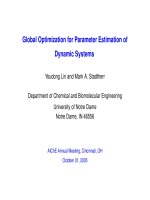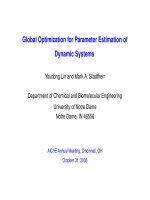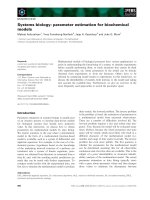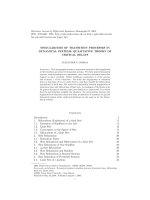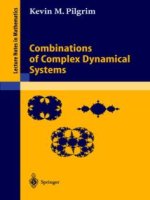Parameter estimation in complex nonlinear dynamical systems
Bạn đang xem bản rút gọn của tài liệu. Xem và tải ngay bản đầy đủ của tài liệu tại đây (6.64 MB, 216 trang )
Parameter Estimation in Complex
Nonlinear Dynamical Systems
Dissertation
Zur Erlangung des akademischen Grades
Doktoringenieur (Dr.-Ing.)
vorgelegt der Fakult¨at f¨ur Informatik und Automatisierung
der Technischen Universit¨at Ilmenau
von M.Eng. Quoc Dong Vu
geboren am 27.12.1975 in Thaibinh
Gutachter
1. Prof. Dr.-Ing. habil. Pu Li
2. Prof. Dr.-Ing. habil. Christoph Ament
3. Prof. Dr. rer. nat. habil. Gerhard-Wilhelm Weber
Tag der Einreichung: 13.04.2015
Tag der wissenschaftlichen Aussprache: 02.10.2015
urn:nbn:de:gbv:ilm1-2015000394
ii
Parameter Estimation in Complex
Nonlinear Dynamical Systems
A Dissertation submitted in partial fulfillment
of the requirements for the degree of
Doctor of Engineering (Dr.-Ing.)
Faculty of Computer Science and Automation
by M.Eng. Quoc Dong Vu
born on 27.12.1975 in Thaibinh
Referees
1. Prof. Dr.-Ing. habil. Pu Li
2. Prof. Dr.-Ing. habil. Christoph Ament
3. Prof. Dr. rer. nat. habil. Gerhard-Wilhelm Weber
Date of submission: 13.04.2015
Date of scientific defense: 02.10.2015
Acknowledgements
My dissertation would certainly never have been finished without the guidance of my
advisor, help from friends, and support from my family during my study at the Group
of Simulation and Optimal Processes (SOP), Ilmenau University of Technology.
Firstly, I would like to express my sincere gratitude to my advisor Professor Pu Li for
the constant support of research, for his ideas, motivation, patience, and continuous
encouragement. His effective guidance and firm requirement promoted me in all the
long time of research and writing of this dissertation.
Besides my advisor, I truly thank the rest of my thesis committee: Professor Christoph
Ament, Professor Gerhard-Wilhelm Weber, Professor Horst Puta, Professor Jens Haueisen, and Professor Daniel Baumgarten, for their time to review my thesis, their insightful comments and advices to improve it.
My completion of this thesis could not have been accomplished without the support
of my current colleagues in our SOP Group, namely, Dr. Siegbert Hopfgarten, Dr.
Abebe Geletu, Dr. Aouss Gabash, Mr. Evgeny Lazutkin, Mr. Xujiang Huang, Mr.
Jens Hollandmoritz, Mr. Bj¨orn T¨opper, Mr. Duc Dai Pham; as well as formers namely,
Dr. Martin Bartl, Mr. Stefan R¨oll, Dr. Hui Zhang, Dr. Ines Mynttinen, Dr. Michael
Kl¨oppel, Mrs. Rim Abdul Jawad, Dr. Jasem Tamimi, Mr. Wolfgang Heß and Mrs.
Rita Helm, with whom my stay at TU Ilmenau became a wonderful experience.
I would like to thank Professor Hongye Su, Professor Weirong Hong, and Dr Chao
Zhao at Zhejiang University for their efficient cooperation in this research.
I greatly appreciate the financial support from Vietnamese Government (Project 322)
and Thuringian Graduate Support Act (Th¨
urGFVO) that funded parts of this research
work. Additional support was provided by the German Academic Exchange Service
(DAAD) for the short visits to Zhejiang University of China in 2008, 2009 and 2010.
I am very thankful to all of my loving Vietnamese friends with whom I shared so much
brilliant times during my stay in Germany.
Last, but not the least, I would like to express my deepest gratitude to my family: to
my beloved wife and son, to my parents and to my brother and sister for their great
love and support during my study.
Abstract
The aim of this dissertation is to develop mathematical/numerical approaches to parameter estimation in nonlinear dynamical systems that are modeled by ordinary
differential equations or differential algebraic equations. Parameters in mathematical
models often cannot be calculated by applying existing laws of nature or measured
directly and therefore they need being obtained from experimental data through an
estimation step. Numerical methods to parameter estimation are challenges due to
undesirable characteristics, such as stiffness, ill-conditioning and correlations among
parameters of model equations that cause computational intensiveness, convergence
problems as well as non-uniqueness of the solution of the parameters. The goal of
this dissertation is therefore two-fold: first to develop efficient estimation strategies
and numerical algorithms which should be able to efficiently solve such challenging
estimation problems, including multiple data profiles and large parameter sets, and
second to develop a method for identifiability analysis to identify the correlations
among parameters in complex model equations.
Direct strategies to solve parameter estimation problem, dynamic optimization problems, include direct sequential, direct simultaneous, direct multiple shooting, quasisequential, and combined multiple shooting and collocation strategy. This dissertation
especially focuses on quasi-sequential strategy and combined multiple shooting and
collocation strategy. This study couples the interior point method with the quasisequential strategy to solve dynamic optimization problems, particularly parameter
estimation problems. Furthermore, an improvement of this method is developed to
solve parameter estimation problems in that the reduced-space method of interior
point strategy is used. In the previous work, combined multiple shooting and collocation strategy method was proved to be efficient to solve dynamic optimization
problems with all constraints of states imposed only at the nodes of the discretization
vi
grids. In this study, an improvement to combined multiple shooting and collocation
strategy is made to impose all state values on constraints at all collocation points in
order to improve the quality of the dynamic optimization problems.
To improve the quality of the parameter estimation solutions, multiple data-sets of
measurement data usually are used. In this study, an extension to a dynamic threestage estimation framework is made to the parameter estimation problem with a
derivation to the quasi-sequential strategy algorithm. Due to the decomposition of
the optimization variables, the proposed approach can efficiently solve time-dependent
parameter estimation problems with multiple data profiles. A parallel computing strategy using the message passing interface (MPI) method is also applied successfully to
boost computation efficiency.
The second challenging task in parameter estimation of nonlinear dynamic models is
the identifiability of the parameters. The identifiability property of a model is used
to answer the question whether the estimated parameters are unique. In this thesis, a
systematic approach to identify both pairwise parameter correlations and higher order
interrelationships among parameters in nonlinear dynamic models is developed. The
correlation information obtained in this way clarifies both structural and practical nonidentifiability. Moreover, this correlation analysis also shows that a minimum number
of data sets, which corresponds to the maximum number of correlated parameters
among the correlation groups, with different inputs for experimental design are needed
to relieve the parameter correlations. The result of this correlation analysis provides a
necessary condition for experimental design in order to collect suitable measurement
data for unique parameter estimation.
Zusammenfassung
Ziel der vorliegenden Dissertationsschrift ist es, mathematische bzw. numerische Verfahren zur Parametersch¨atzung f¨
ur nichtlineare dynamische Systeme zu entwickeln,
deren Modelle in Form von gew¨ohnlichen Differentialgleichungen oder differentialalgebraischen Gleichungen vorliegen. Derartige Modelle zu validieren gelingt in der
Regel nicht, indem Naturgesetze ausgenutzt werden k¨onnen, vielmehr sind h¨aufig
aufwendige Messungen erforderlich, deren Datens¨atze dann auszuwerten sind. Numerische Verfahren zur Parametersch¨atzung unterliegen solchen Herausforderungen
und unerw¨
unschten Effekten wie Steifheit, schlechter Konditionierung oder Korrelationen zwischen zu sch¨atzenden Parametern von Modellgleichungen, die rechenaufwendig
sein, aber die auch schlechte Konvergenz bzw. keine Eindeutigkeit der Sch¨atzung
aufweisen k¨onnen. Die Arbeit verfolgt daher zwei Ziele: erstens effektive Sch¨atzstrategien
und numerische Algorithmen zu entwickeln, die komplexe Parameter-Sch¨atzprobleme
l¨osen und dazu mit multiplen Datenprofilen bzw. mit großen Datens¨atzen umgehen
k¨onnen. Zweites Ziel ist es, eine Methode zur Identifizierbarkeit f¨
ur korrelierte Parameter in komplexen Modellgleichungen zu entwickeln.
Eine leistungsf¨ahige direkte Strategie zur L¨osung von Parameter-Sch¨atzaufgaben ist
die Umwandlung in ein Problem der optimalen Steuerung. Dies schließt folgende
Methoden ein: direkte sequentielle und quasi-sequentielle Verfahren, direkte simultane
Strategien, direkte Mehrfach-Schießverfahren und kombinierte Mehrfach-Schießverfahren
mit Kollokationsmethoden. Diese Arbeit orientiert besonders auf quasi-sequentielle
Verfahren und kombinierte Mehrfach-Schießverfahren mit Kollokationsmethoden. Speziell
zur L¨osung von Parametersch¨atzproblemen wurde die Innere-Punkte-Verfahren mit
dem quasi-sequentielle Verfahren gekoppelt. Eine weitere Verbesserung zur L¨osung
von Parametersch¨atzproblemen konnte erreicht werden, indem die „reduced-space“
Technik der Innere-Punkte-Verfahren benutzt wurde. Die Leistungsf¨ahigkeit der kom-
viii
binierte Mehrfach-Schießverfahren mit Kollokationsmethoden zur L¨osung von Dynamischen Optimierungsproblemen war bisher damit verbunden, dass die Zustandsbeschr¨ankungen nur in den Knoten des Diskretisierungsgitters eingehalten werden
konnten. Mit dieser Arbeit konnte die kombinierte Mehrfach-Schießverfahren mit
Kollokationsmethoden verbessert werden, so dass alle Zustandsgr¨oßen die vorgegebenen Beschr¨ankungen in allen Kollokationspunkten einhalten, was zu einer deutlichen
Verbesserung des letztlich zu l¨osenden Optimalsteuerungsproblems zur Parametersch¨atzung f¨
uhrt.
Um die Qualit¨at Parametersch¨atzung zu verbessern, werden u
¨blicherweise mehrfache
Messdatens¨atze benutzt. In der vorgelegten Dissertation wurde zur Parametersch¨atzung
eine dynamische Drei-Stufen-Strategie mit einem eingebauten quasi-sequenziellen Verfahren entwickelt. Durch die Zerlegung der Optimierungsvariablen kann das vorgeschlagene Verfahren sehr effizient zeitabh¨angige Parameter–Sch¨atzaufgaben mit mehrfachen
Datenprofilen l¨osen. Zur Steigerung der Recheneffizienz wurde dar¨
uber hinaus erfolgreich eine Parallel-Rechner Strategie eingebaut, die das sog. „message passing interface“ (MPI) nutzt.
Eine zweite Herausforderung f¨
ur die Parametersch¨atzung nichtlinearer dynamischer
Modelle betrifft die Indentifizierbarkeit der Parameter. Damit verbunden ist die Frage
nach der Eindeutigkeit der gesch¨atzten Parameter. In dieser Arbeit wird auch ein
systematisches Vorgehen zur Identifizierung paarweiser Korrelationen als auch zum
Erkennen von Wechselwirkungen h¨oherer Ordnung zwischen Parametern in nichtlinearen dynamischen Systemen vorgeschlagen. Damit l¨asst sich sowohl die strukturelle als auch eine praktische „Nichtidentifizierbarkeit“ kl¨aren. Dar¨
uber hinaus
l¨asst sich durch eine Korrelationsanalyse darauf schließen, welche minimale Zahl von
Datens¨atzen mit unterschiedlichen Eing¨angen zum Entwurf ben¨otigt wird, um Parameterkorrelationen auszuschließen. Dies wiederum entspricht einer maximalen Zahl von
korrelierten Parametern innerhalb der Korrelations–Gruppen. Im Ergebnis der Korrelationsanalyse erh¨alt man eine notwendige Bedingung wie viele Messdaten f¨
ur eine
eindeutige Parametersch¨atzung ben¨otigt werden.
Contents
Contents
ix
List of Figures
xv
List of Tables
xix
Abbreviations
xxii
1 Introduction
1
1.1
Research Motivation . . . . . . . . . . . . . . . . . . . . . . . . . . . .
1
1.2
Structure and Contribution of the Thesis . . . . . . . . . . . . . . . . .
4
1.3
Publications . . . . . . . . . . . . . . . . . . . . . . . . . . . . . . . . .
9
1.3.1
Journal Papers . . . . . . . . . . . . . . . . . . . . . . . . . . .
9
1.3.2
Proceedings . . . . . . . . . . . . . . . . . . . . . . . . . . . . .
9
2 Parameter Estimation Theory: A review
11
2.1
System Identification Problems . . . . . . . . . . . . . . . . . . . . . . 12
2.2
Parameter Estimation of DAEs systems . . . . . . . . . . . . . . . . . . 15
2.3
Parameter estimation - Optimization of Dynamic Systems . . . . 23
x
Contents
2.3.1
Numerical methods to DOPs . . . . . . . . . . . . . . . . . . . . 24
2.3.2
Identifiability analysis . . . . . . . . . . . . . . . . . . . . . . . 27
3 Fundamentals of Direct Methods to Dynamic Optimization Problems
31
3.1
Discretization of Independent Variables
3.2
Numerical methods for solving DAEs Systems . . . . . . . . . . . . . . 33
3.3
. . . . . . . . . . . . . . . . . 32
3.2.1
Backward Differentiation Formulas Methods . . . . . . . . . . . 35
3.2.2
Collocation on Finite Elements . . . . . . . . . . . . . . . . . . 37
3.2.3
Sensitivity Calculations . . . . . . . . . . . . . . . . . . . . . . . 46
3.2.3.1
Direct Sensitivity Computation . . . . . . . . . . . . . 47
3.2.3.2
Collocation-based Sensitivity Computation . . . . . . . 48
Methods for Solving Nonlinear Optimization Problems . . . . . . . . . 49
3.3.1
Basic definitions and theorems . . . . . . . . . . . . . . . . . . . 50
3.3.2
Quadratic Programming . . . . . . . . . . . . . . . . . . . . . . 52
3.3.2.1
Equality constrained quadratic programming . . . . . 53
3.3.2.2
Inequality constrained quadratic programming . . . . . 54
3.3.3
Active-Set Sequential Quadratic Programming Methods . . 56
3.3.4
Interior-Point Methods . . . . . . . . . . . . . . . . . . . . . . . 59
3.3.5
Summary of Numerical Method for NLPs . . . . . . . . . . . . . 63
3.4
Sequential approach . . . . . . . . . . . . . . . . . . . . . . . . . . . . . 64
3.5
Simultaneous approach . . . . . . . . . . . . . . . . . . . . . . . . . . . 64
3.6
Quasi-sequential approach . . . . . . . . . . . . . . . . . . . . . . . . . 66
3.7
Multiple shooting . . . . . . . . . . . . . . . . . . . . . . . . . . . . . . 69
xi
Contents
3.8
Combined multiple shooting and collocation strategy . . . . . . . . . 71
4 Improved Approaches to Dynamic Optimization
4.1
Interior Point Quasi-sequential approach . . . . . . . . . . . . . . . . . 76
4.1.1
The nonlinear programing problem formulation . . . . . . . . . 77
4.1.2
Case studies . . . . . . . . . . . . . . . . . . . . . . . . . . . . . 79
4.1.3
4.2
4.3
75
4.1.2.1
The Rosenbrock two-dimensional optimization problem 79
4.1.2.2
Optimal control of a CSTR . . . . . . . . . . . . . . . 80
Conclusions . . . . . . . . . . . . . . . . . . . . . . . . . . . . . 83
Reduced-Space Interior Point Quasi-sequential approach . . . . . . . . 83
4.2.1
NLP Problem formulation . . . . . . . . . . . . . . . . . . . . . 84
4.2.2
Interior-point approach . . . . . . . . . . . . . . . . . . . . . . . 84
4.2.3
Reduced-space interior-point approach formulation . . . . . . . 86
4.2.4
Jacobian computation . . . . . . . . . . . . . . . . . . . . . . . 87
Parameter Estimation Problems framework with Multiple Datasets . . 88
4.3.1
Error-In-Variables formulation of parameter estimation problem
89
4.3.2
Three-layer Quasi-Sequential Approach . . . . . . . . . . . . . . 91
4.3.2.1
The upper stage . . . . . . . . . . . . . . . . . . . . . 93
4.3.2.2
The middle stage . . . . . . . . . . . . . . . . . . . . . 93
4.3.2.3
The lower stage . . . . . . . . . . . . . . . . . . . . . . 94
4.3.2.4
Calculation of the gradient and sensitivity matrix
. . 97
4.3.3
Parallel computing . . . . . . . . . . . . . . . . . . . . . . . . . 99
4.3.4
A case study: parameter estimation of the CSTR model . . . . 100
xii
Contents
4.3.5
4.4
4.3.4.1
The interior point quasi-sequential approach . . . . . . 100
4.3.4.2
The parallel computation approach . . . . . . . . . . . 105
Summary . . . . . . . . . . . . . . . . . . . . . . . . . . . . . . 106
An improved Multiple-Shooting Approach . . . . . . . . . . . . . . . . 111
4.4.1
Sequential simulation layer . . . . . . . . . . . . . . . . . . . . . 112
4.4.2
Parallel simulation layer . . . . . . . . . . . . . . . . . . . . . . 112
4.4.3
Case studies . . . . . . . . . . . . . . . . . . . . . . . . . . . . . 115
4.4.4
4.4.3.1
Control of a van der Pol oscillator . . . . . . . . . . . . 115
4.4.3.2
Control of the nonlinear CSTR system . . . . . . . . . 119
4.4.3.3
Parameter estimation of a three-step pathway model . 120
Summary . . . . . . . . . . . . . . . . . . . . . . . . . . . . . . 127
5 Identifiability analysis based on identification of parameter correlations
133
5.1
Introduction . . . . . . . . . . . . . . . . . . . . . . . . . . . . . . . . . 134
5.2
Definitions . . . . . . . . . . . . . . . . . . . . . . . . . . . . . . . . . . 134
5.3
Structural identifiability analysis . . . . . . . . . . . . . . . . . . . . . 136
5.4
Practical identifiability analysis . . . . . . . . . . . . . . . . . . . . . . 139
5.5
A new approach to detect parameter correlations . . . . . . . . 140
5.6
5.5.1
Identification of parameter correlations . . . . . . . . . . . . . . 141
5.5.2
Interpretation of parameter correlations . . . . . . . . . . . . . . 145
Case studies . . . . . . . . . . . . . . . . . . . . . . . . . . . . . . . . . 147
5.6.1
A generic branched pathway as S-system . . . . . . . . . . . . . 147
5.6.2
A three-step pathway model . . . . . . . . . . . . . . . . . . . . 151
xiii
Contents
5.7
5.6.2.1
Identification of correlations . . . . . . . . . . . . . . . 152
5.6.2.2
Verification of the correlations by fitting the model . . 154
Conclusions . . . . . . . . . . . . . . . . . . . . . . . . . . . . . . . . . 161
6 Conclusions and Future research
165
6.1
Conclusions . . . . . . . . . . . . . . . . . . . . . . . . . . . . . . . . . 165
6.2
Future research . . . . . . . . . . . . . . . . . . . . . . . . . . . . . . . 167
References
169
Appendix A Supplementary Material
185
A.1 The sensitivity matrix derivation . . . . . . . . . . . . . . . . . . . . . 185
A.1.0.3 Case 1 . . . . . . . . . . . . . . . . . . . . . . . . . . . 186
A.1.0.4 Case 2 . . . . . . . . . . . . . . . . . . . . . . . . . . . 186
A.2 The partial derivative functions of the three-step-pathway model . . . . 187
List of Figures
1.1
Structure and Contribution of the Thesis1 . . . . . . . . . . . . . . . . .
2.1
Block diagram of transition of system identification levels . . . . . . . . 12
2.2
A simple diagram of grey-box system modeling
2.3
Block diagram of the parameter estimation of differential algebraic
equations (DAEs) system procedure . . . . . . . . . . . . . . . . . . . . 17
2.4
Numerical methods to dynamic optimization problems . . . . . . . . . 28
3.1
Parameterization of independent variable methods . . . . . . . . . . . . 34
3.2
Collocation on finite elements (NC=3) . . . . . . . . . . . . . . . . . . 46
4.1
Solution path with respect to different initial point . . . . . . . . . . . 80
4.2
Optimal trajectories of control variables
4.3
Diagram of the three-stage computation framework . . . . . . . . . . . 92
4.4
Flowchart of the three-stage serial computation framework . . . . . . . 95
4.5
Structure of two-layer optimization . . . . . . . . . . . . . . . . . . . . 96
4.6
Parallel timing diagram . . . . . . . . . . . . . . . . . . . . . . . . . . . 99
4.7
Measurement of 10 data sets . . . . . . . . . . . . . . . . . . . . . . . . 103
4.8
Parameter identification results with 10 data sets in three cases . . . . 103
8
. . . . . . . . . . . . . 14
. . . . . . . . . . . . . . . . . 82
xvi
4.9
List of Figures
Parameter p1 identification results with full and lack of measurement
of variables . . . . . . . . . . . . . . . . . . . . . . . . . . . . . . . . . 104
4.10 Estimation of variables c and T with full measurement of variables . . . 104
4.11 Estimation of variables c and T with lack of measurement of c variable 105
4.12 Flowchart of the three-stage parallel computation framework . . . . . . 107
4.13 CPU performance of the CSTR parameter estimation (PE) problem in
parallel mode . . . . . . . . . . . . . . . . . . . . . . . . . . . . . . . . 108
4.14 Parallel computation of the CSTR parameter estimation . . . . . . . . 108
4.15 CPU time of the van der Pol control problem with x1 constraint . . . . 117
4.16 x(t) profile with x1 constraint of the van der Pol control problem . . . . 117
4.17 u(t) profile with x1 constraint of the van der Pol control problem
. . . 119
4.18 Parallel computation performance of the CSTR control in MPI mode . 120
4.19 Performance of the PC in parallel computation with over 5 nodes . . . 122
4.20 State profiles of the AMIGO package in the high initials case . . . . . . 127
4.21 State profiles of the AMIGO package in the high initials case (continued)128
4.22 State profiles of the modified combined multiple shooting and collocation strategy (CMSC) in the high initials case . . . . . . . . . . . . . . 129
4.23 State profiles of the modified CMSC in the high initials case (continued) 130
5.1
Dendrogram of the generic branched pathway . . . . . . . . . . . . . . 149
5.2
Correlated relations between p1 and p3 . . . . . . . . . . . . . . . . . . 151
5.3
Dendrogram of the three-step pathway model . . . . . . . . . . . . . . 156
5.4
Correlated relations between p35 and p36 based on fitting the model to
5 individual data sets with different inputs . . . . . . . . . . . . . . . . 156
5.5
Fitting to the same 2 data sets together
. . . . . . . . . . . . . . . . . 157
List of Figures
xvii
5.6
Relationships of p35 with other parameters by fitting to different numbers of noise-free data sets with different inputs . . . . . . . . . . . . . 158
5.7
Relations between p28 , p29 , and p30 based on fitting the model to 3
individual noise-free data sets with different inputs . . . . . . . . . . . 158
List of Tables
3.1
Shifted Lagrange orthogonal polynomials . . . . . . . . . . . . . . . . . 42
3.2
Orthogonal collocation points at the roots of shifted Lagrange polynomials 44
4.1
Comparison of different approaches to the CSTR problem
4.2
CPU time and number of iterations . . . . . . . . . . . . . . . . . . . . 103
4.3
Parallel computation of the CSTR parameter estimation . . . . . . . . 111
4.4
Results of the van der Pol Control problem . . . . . . . . . . . . . . . . 118
4.5
CPU time (second) and OBJ value of the CSTR control problem . . . . 121
4.6
CPU time comparison between AMIGO and modified CMSC . . . . . . 124
4.7
Result of parameter estimation problem of three path-way . . . . . . . 125
4.8
Result of parameter estimation problem of three path-way (continued) . 126
5.1
Parameter values of model Eqs. (5.21) based on one and two datasets
5.2
P and S values for generating 5 datasets . . . . . . . . . . . . . . . . . 154
5.3
Fitted parameter values based on different data sets . . . . . . . . . . . 155
5.4
Measurable variable sets for a successful fitting . . . . . . . . . . . . . . 161
. . . . . . . 83
150
Abbreviations
AEs algebraic equations. 16
BDF backward differentiation formula. 35–37, 47
CMSC combined multiple shooting and collocation strategy. xiv, xvii, 5, 6, 27, 71,
75, 76, 111, 112, 116, 117, 119, 123–127, 129, 130, 166, 167
CSTR continuous stirred tank reactor. 80, 89, 100
DAE differential algebraic equation. 4, 5, 25, 26, 33, 35, 36, 47, 64–66, 70, 87, 90,
92, 165
DAEs differential algebraic equations. xiii, 1, 2, 4, 5, 11, 13–17, 22, 23, 25, 27, 31,
35, 37, 45–47, 65, 71, 87, 88, 90
DMS direct multiple shooting strategy. 26, 27, 70, 71
DOP dynamic optimization problem. 1, 24, 64, 66, 71, 75, 81, 119, 123, 165
DOPs dynamic optimization problems. 2, 4, 5, 25, 26, 31, 65, 75, 83, 127, 131, 166,
167
DSM direct simultaneous strategy. 25–27, 65, 66, 70, 71
DSQ direct sequential strategy. 5, 24–27, 66, 68, 70
EIV error-in-variables. 76, 89, 90, 102, 105
FIM Fisher information matrix. 3
GA genetic algorithm. 90
xxii
Abbreviations
GLS generalized least squares estimation. 20
HPC high performance computing. 99, 106
IP interior-point. 2, 4–6, 76, 79, 82, 83, 86, 89, 90, 92, 97, 98, 105, 106, 109, 110, 114,
116, 119, 123, 166
IVP initial value problem. 112
IVPs initial value problems. 31
ML maximum likelihood estimation. 21
MPC model predictive control. 88
MPI message passing interface. iv, 5, 99, 100, 105, 106, 112, 119, 166
NLP nonlinear programming. 2, 3, 5, 24–27, 31, 62–65, 67–70, 73, 75–79, 82, 87,
89–94, 98, 105, 106, 109–111, 113, 114, 116, 123, 167
NLPs Nonlinear Programming Problems. 4, 31, 75, 89, 93, 106, 167
ODE ordinary differential equation. 4, 26, 35, 47, 59, 70, 165
ODEs ordinary differential equations. 1, 4, 13, 14, 16, 35, 37, 47, 120, 147
OpenMP Open Multi-Processing. 99, 100
PDEs partial differential equations. 13
PE parameter estimation. xiv, 1–6, 16, 75, 76, 90, 100, 101, 108, 120, 122, 123,
165–167
PSO particle swarm optimization. 90
QSQ quasi-sequential strategy. 5, 6, 26, 27, 66, 71, 106, 116, 119, 166
RS reduced-space. 5, 6
SQP sequential quadratic programming. 4, 5, 27, 68, 69, 73, 75, 82, 83, 90, 113
Chapter 1
Introduction
1.1
Research Motivation
Mathematical models have been used to describe real world systems in a vast range
of engineerings, such as chemical engineering, electrical engineering, mechanical engineering, and aerospace engineering, as well as in non-technical areas of natural sciences
such as chemistry, physics, biology, medicine, and geo-sciences and economics, etc. Developing compact and accurate mathematical models for dynamic systems is essential
in these fields for analyzing and simulating the system dynamics and implementation
of optimization and control strategies [Gevers, 2006; Ljung, 2010; Nieman et al., 1971;
¨ om and Eykhoff, 1971].
Astr¨
By applying a priori knowledge and existing laws of nature, mathematical models can
be built in the form of ordinary differential equations or differential algebraic equations
with many unknown coefficients or parameters that cannot be computed or measured
directly. As a consequence, a complex DAEs or ordinary differential equations (ODEs)
constrained optimization problem needs to be solved to estimate these parameters
based on experimental data, leading to a parameter estimation problem.
With a popular objective function of least squares types, the PE of a DAEs system
poses a dynamic optimization problem that can be solved by sophisticated numerical
methods. Numerical methods to dynamic optimization problem (DOP) are challenges
due to computational intensiveness and numerical difficulties that are caused by unde-


